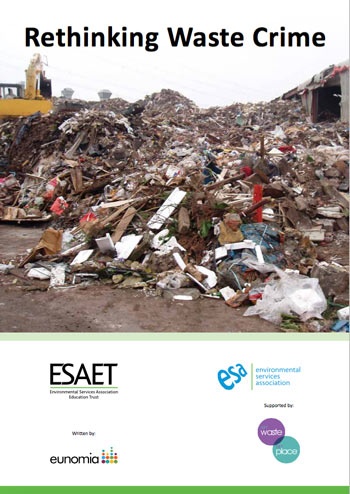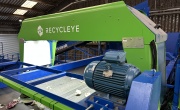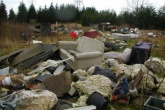More regulation needed to fight waste criminals robbing industry and public of £604m
Waste crime in England costs £604 million a year in losses to the waste industry and the taxpayer – the equivalent to paying for over 4,000 NHS hospital beds a year or building 34 new secondary schools, according to the Environmental Services Association (ESA).
 Government figures released earlier this year revealed that councils in England spent £50 million clearing up incidences of fly-tipping last year, but the ESA’s new report, ‘Rethinking Waste Crime’, launched yesterday (2 May) at the House of Commons, reveals the extent of illegal waste operations’ effect on both public and private sectors, at a time when council budgets are stretched to breaking point.
Government figures released earlier this year revealed that councils in England spent £50 million clearing up incidences of fly-tipping last year, but the ESA’s new report, ‘Rethinking Waste Crime’, launched yesterday (2 May) at the House of Commons, reveals the extent of illegal waste operations’ effect on both public and private sectors, at a time when council budgets are stretched to breaking point.
The majority of the waste involved in waste crime, the report written by Eunomia Research and Consulting says, is associated with waste from businesses rather than households, and is the result of the evolution of the waste sector to allowing businesses to use waste as a resource for recycling and recovery.
It suggests that as the sector, which adds around £6.6 billion to the UK economy, has moved from focusing on waste disposal to recovering resources for further use, regulation has ‘not kept up’, leaving gaps that can be exploited by illegal traders and operators.
Most serious waste crime falls into one of six categories: illegal waste sites, inaccurately describing waste, illegal export of waste, illegal burning of waste, fly-tipping and serious breaches of permit conditions.
It is weak regulation, says the ESA, that is a major cause of this waste crime, which damages the environment, blights local communities, undermines legitimate businesses and costs the government in both clean-up costs and lost revenues paid by operators.
For example, anyone can obtain a licence to carry waste by paying a small online fee and undergoing minimal checks, while the ESA says that waste carriers or sites that operate under exemptions rather than proper waste permits (for example, some recovery of scrap metal or treating waste on a small scale to produce aggregate or soil) are rarely inspected, while there is no way to track commercial waste from its production through to its end destination.
Speaking at the report’s launch yesterday afternoon, Jacob Hayler, Executive Director at the ESA, said that it is now “far too easy” for criminals to get into the industry, get their hands on materials and continue to operate with impunity.
“Regulators have been under-resourced and encouraged to take a light-touch approach in order to be business friendly”, said Mike Brown, Managing Director of report authors Eunomia. “Ironically, this is actually harming the interests of legitimate waste businesses while giving criminals an easy ride. The solution isn’t to abandon the progress we’ve made, but to modernise regulation to support our increasingly circular economy.”
‘No simple fix’, but regulation tightening a start

That report highlighted the significant return on investment that the public can gain from putting in place resources to combat illegal activity in the waste sector. The 2015 Autumn Statement allocated an extra £23 million to the Environment Agency to be spread over the following five years.
However, the ESA and Eunomia says that the problem is getting worse, and spending more money alone will not lead to a lasting difference. An approach that ‘targets the underlying causes of crime’ in the sector and ‘roots out the prevailing culture’ allowing waste crime to flourish is needed.
While the ESA admits that there is ‘no simple fix’ to the blight of waste crime, the ‘Rethinking Waste Crime’ report suggests a package of measures that would modernise England’s ‘out of date’ waste management system.
Among the proposals are:
- the tightening up of regulation in areas that are ‘barely regulated’, closing gaps in regulation and reducing exemptions for waste sites;
- strengthening enforcement throughout the waste chain and introducing a new inspection regime for sites;
- obliging local authorities to provide end destination reports and ensure that none of the waste overseen by local authorities is ever sent to poorly performing or illegal sites;
- developing a new electronic waste transfer note system to improve traceability of waste;
- banning serious and repeat offenders from the sector; and
- securing new funding from criminals for the Environment Agency.
Through the ‘Right Waste, Right Place’ campaign run by the ESA and sponsored by the Environment Agency and Chartered Institution of Wastes Management (CIWM), small and medium sized businesses have been encouraged to take greater caution in following the Duty of Care, which requires all producers of waste to ensure that it is legally disposed of, with those failing to comply running the risk of being hit with an unlimited fine in England.
Hayler said: “Despite additional funding for regulators and stronger enforcement powers, waste crime is more entrenched than ever.
“Clearly, we need a different approach which targets the underlying causes of crime in our sector and which roots out the prevailing culture which allows waste crime to flourish. This report highlights the weakness in the current regime and puts forward ambitious recommendations aimed at stopping waste crime once and for all.”
As an example of the ease at which anyone can obtain a permit to handle waste, Brown recalled an occasion during Eunomia’s research where the company was able to register his dog Oscar as a waste carrier, giving him a three-year permit without any test of identity or competence and at the cost of just £154. While ten years ago there were 80,000 registered waste carriers, today Brown says there are over 180,000.
Action, he says, should centre on ensuring that businesses have fewer, more competent waste carriers, brought about by increasing regulation. “The waste sector’s very existence is based on regulation and enforcement. If you want less regulation, you will have more crime, and the industry does not want a light touch approach.”
The full ‘Rethinking Waste Crime’ report can be read on the ESA’s website.









